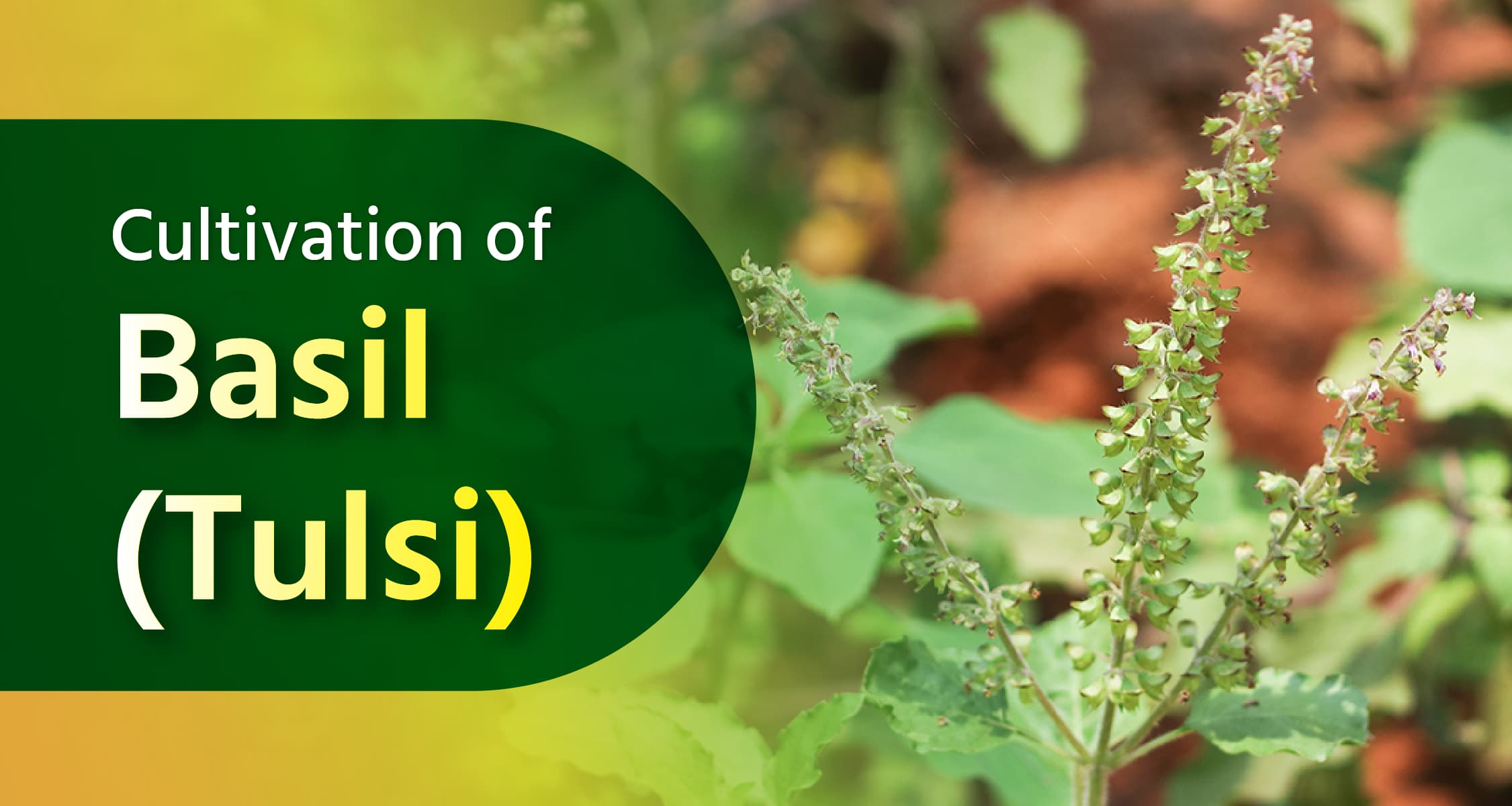Cultivation of Basil (Tulsi)

Basil has many medicinal properties. Consuming basil leaves can provide relief from ailments like cough, cold, and fever. It is used to prepare various Ayurvedic medicines. Due to the increasing demand for Ayurvedic medicines, many major pharmaceutical companies are engaging in contract farming of basil. Farmers who engage in commercial cultivation of basil can earn good profits in a short period. Basil plants do not require much irrigation and are less prone to pests, making the cultivation cost-effective. However, it is important to have some essential information before starting basil farming. If you are interested in cultivating basil, you can find all the necessary information below as you read through.
How to Cultivate Basil?
Soil
- Basil cultivation thrives in less fertile soil with proper drainage. Sandy loam soil is highly suitable for it.
Climate
- Both tropical and subtropical climates are suitable for basil cultivation.
Sowing Time
- April- May is the best time for sowing seeds. Seeds start germinating within 1 to 2 weeks after sowing. The rainy season is ideal for plant growth. Transplant nursery-raised seedlings to the main field in June-July. Transplanting can also be done in October-November.
Seed Rate
- For cultivation on one acre of land, 80 to 120 grams of seeds are required.
Varieties
French Basil and Sweet Basil are grown for their spice and medicinal properties.
Kapoor Tulsi is famous for its distinctive fragrance.
Black Tulsi is known for its medicinal properties.
Wild Tulsi (Vana Tulsi) is found naturally in forests and is used in Ayurvedic treatments.
Shri Tulsi and Shyama Tulsi are also quite popular for their special medicinal properties.
Planting
- Seeds begin to germinate within 1 to 2 weeks after sowing. The rainy season is the best for plant growth. Transplant nursery-raised seedlings to the main field in June-July. Transplanting can also be done in October-November. Plant in rows with 60 cm between rows and 30 cm between plants. Prepare nursery beds with a depth of 15-20 cm and a size of 1x1 meter. Maintain a sand-to-soil ratio of 1:10. Keep a row-to-row distance of 8-10 cm.
Fertilizers and Manure
- Tulsi (basil) has many medicinal properties. To achieve high-quality crops, avoid using chemical fertilizers and manures. If fertilizers are needed, use organic ones. For each acre of land, use 6 tons of well-rotted cow dung manure, 35 to 40 kilograms of urea, 80 kilograms of DAP, and 32 kilograms of MOP per acre. Avoid using fertilizers during very hot or very cold weather.
Irrigation
- In the summer, irrigate 2 to 3 times a month. Irrigation is not needed during the rainy season. Only irrigate in winter if necessary. Stop irrigation 10 days before harvesting. In summer, irrigate three times a month, and during the rainy season, no irrigation is needed. Annually, 12-15 irrigations are required. Perform the first irrigation after planting and the second after the new plants have stabilized. Two irrigations are essential, and the rest should be based on the weather. In areas prone to waterlogging during the rainy season, ensure proper drainage.
Weed Management
- The first weeding and hoeing should be done one month after planting. The second weeding and hoeing should be done 3-4 weeks after the first. In large areas, hoeing can be done using a tractor.
Disease and Pest Management
- Tulsi cultivation faces several major diseases and pests, such as leaf curl caterpillars, leaf spot disease, blight, and root rot. Proper management and care are essential to prevent these issues, including good drainage, crop rotation, and the use of organic pesticides. Regular inspections and prompt measures can help control these problems.
Harvesting
- The first harvest can be done three months after planting. If cultivating tulsi for oil extraction, cut the upper parts of the plants, i.e., 25 to 30 centimeters from the top. The oil content decreases after the plants flower, so do not delay harvesting.
Yield
- The average yield of tulsi is 10 to 15 tons per acre, with oil yield ranging from 32 to 40 kilograms per acre.
Medicinal Properties and Benefits of Tulsi
Cough and Cold: Consuming Tulsi leaves provides relief from cough and cold. Tulsi has natural antibiotic and antiseptic properties that help clean the respiratory system.
Hiccups and Vomiting: The juice of Tulsi leaves is effective in reducing hiccups and vomiting. It helps balance the digestive system.
Bad Breath: Tulsi leaves are effective in eliminating bad breath, acting as a natural mouth freshener.
Pain Relief: Tulsi consumption helps alleviate various types of pain such as headaches, stomach aches, and muscle pain.
Leprosy: Tulsi leaves are also used in the treatment of severe diseases like leprosy. They help in healing skin disorders.
Eye Disorders: The juice of Tulsi leaves is beneficial for eye ailments and helps improve vision.
Religious Significance: There is a tradition of offering Tulsi as a prasadam (offering to God). It is believed that consuming Tulsi as prasadam allows it to enter the body in its natural form, helping to eliminate internal issues and removing any toxins from the body.
No Side Effects: One of the biggest advantages of Tulsi is that it does not cause any side effects. It is a completely safe and natural remedy.
Immunity Boosting: Regular consumption of Tulsi boosts immunity and enables the body to fight diseases.
Stress Reduction: Tulsi helps reduce mental stress and anxiety, providing mental peace and stability.
Blood Purification: Tulsi assists in purifying the blood by eliminating impurities and promoting healthy blood circulation.
Antioxidant Properties: Tulsi has antioxidant properties that protect the body from free radicals and prevent cellular damage.
Do you want to grow tulsi (basil)? If yes, let us know in the comments. For more interesting and important information, follow the 'Horticulture' channel now. If you liked this post, please like it and share it with your farmer friends.
Frequently Asked Questions (FAQs)
Q: When is basil cultivation done?
A: Basil is sown in April-May and transplanted in June-July.
Q: What type of soil is suitable for basil cultivation?
A: Sandy loam soil is the most suitable for basil cultivation.
Q: How much irrigation do basil plants need?
A: Water 2-3 times during the summer and as needed during the winter.
Q: How much seed is required for basil cultivation?
A: 80 to 120 grams of seed per acre is needed.
Q: When should basil be harvested?
A: Harvest should be done 3 months after transplanting and before the plants start flowering.
जारी रखने के लिए कृपया लॉगिन करें

फसल चिकित्सक से मुफ़्त सलाह पाएँ
